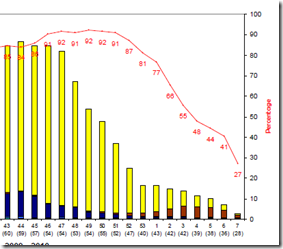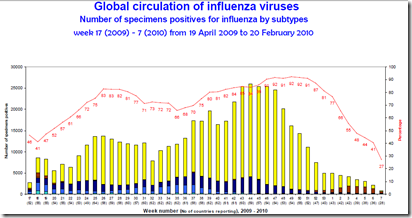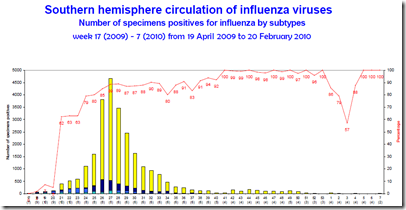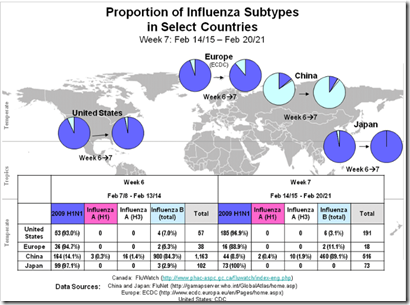# 4408
An interesting comparison this morning between the mix of influenza viruses being seen in the Northern and Southern Hemispheres right now.
North of the equator, we are still in the middle of what would be traditionally the peak of our influenza season, and yet influenza activity is declining and is below what is normally seen this time of year in most regions.
Globally, what little influenza activity that is being reported is predominantly influenza B, as indicated by this chart from the latest virological data supplied by the World Health Organization.
The yellow bars indicated pandemic H1N1 flu.


(blowup of last 18 weeks of data)
Pandemic influenza (in the northern hemisphere) has gone from representing more than 90% of all flu cases 3 months ago, to only 27% today.
Flu season south of the equator is still several months away, and the levels of influenza being reported there are understandably very low. Interestingly, nearly 100% of what is being reported is coming back as pandemic H1N1.
Note the scale change from the above chart.

Quite obviously novel H1N1 isn’t having the same `summer impact’ in the Southern Hemisphere that we experienced last year north of the equator (even taking into account the disparity in populations).
And even across the Northern Hemisphere, there is a wide divergence in the mix of influenza being seen.
The WHO’s latest virological report indicates that Influenza B is now the big player in China and Hong Kong, although its impact remains low in North America.
As for what all this bodes for the rest of the year?
Well . . . influenza is notoriously unpredictable.
Stay tuned.
Pandemic (H1N1) 2009 - update 90
Weekly virological surveillance update
5 March 2010 -- Pandemic influenza A(H1N1) 2009 circulating viruses have continued to decrease in most countries of the Northern Hemisphere in recent weeks. Little activity has been reported in the Southern Hemisphere in 2010 to date. In most countries where detection of human influenza virus was reported, the pandemic influenza A(H1N1) continues to be predominating subtype among all influenza A viruses subtyped (87.3% in North America region, 86% in the European region and 75% globally). The number of pandemic influenza A(H1N1) viruses tested globally has decreased over recent weeks. Seasonal A(H1N1) viruses continue to be detected very sporadically in only a few countries. Sporadic influenza A(H3N2) activity has also been reported from some countries. As in recent weeks, influenza B activity has continued to increase in China and China, Hong Kong SAR. Other countries reporting an increase in influenza B activity included Iran, Mongolia and United Republic of Tanzania.
Based on FluNet reporting for the week from 14-20 February 2010, the total number of specimens reportedly positive for influenza viruses by National Influenza Centre (NIC) laboratories from 28 countries was 898. Of these, 365/898 (40.6%) were typed as influenza A and 533 (59.4%) as influenza B. Compared the previous reporting week, this represents an overall decrease in the proportion of influenza A positive specimens relative to the influenza B positives. Of all sub-typed influenza A viruses, 75% (243/365) were pandemic A(H1N1) 2009. China continued to report increased influenza B activity accounting for 88.4% of all influenza detections in the reporting week, while in China, Hong Kong SAR it represented 54.5% of circulating influenza.


